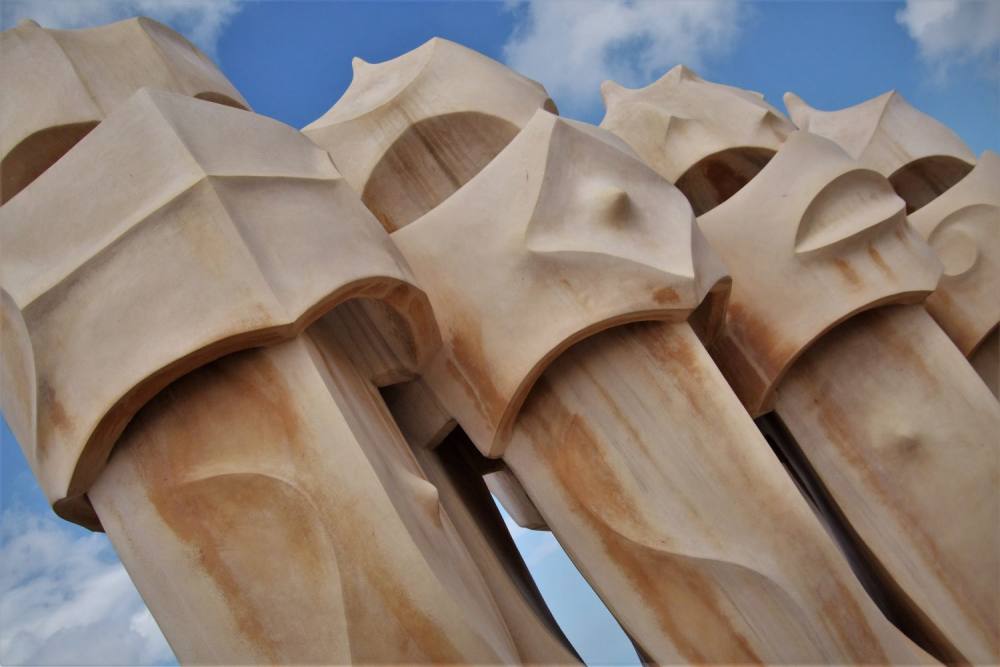- Barcelona was our last stop in Spain. We rented an apartment for five nights in a residential area near Placa de Catalunya, with the aim of slowing down and taking time to enjoy being in this legendary city. It worked a treat.
- One day we visited the Picasso Museum, wandered down to the waterfront, then came home via the Cathedral district.
- Across a couple of days we checked out the extraordinary architecture of Antoni Gaudi and his contemporaries. Casa Batllo, Casa Mila, Sagrada Familia, Parc Guell, and other lesser known but amazing buildings.
- We explored Montjuic and visited the Mies van de Rohe’s gorgeous Barcelona Pavillion and the Joan Miro Museum.
- In the rest of our time we wandered the backstreets, visited smaller churches and museums, and took in a concert at the shimmering Palace of Catalan Music. We left Barcelona vowing to come back.
- We arrived late on the first night, having taken the slow train from Granada to check out some Spanish countryside along the way.
- Our first full day was spent wandering down Via Laietana to the waterfront then back again, visiting some great sites in the La Ribera and Barri Gotic districts. Via Laietana runs parallel to the famous La Rambla, which is very crowded and touristy, and we found it a good option for easing ourselves in to this bustling city.
- The Palace of Catalan Music is a lovely modernist building by the architect (and politician) Lluís Domènech i Montaner. It’s possible to see the interior on a guided tour. We didn’t take a tour but attended a concert one evening by Diego el Cigala, a well known Romani Flamenco gypsy singer. Either way it’s worth a look inside to see the beautiful stained glass ceiling. The Palace of Catalan Music and Montaner’s Hospital de Sant Pau are collectively recognised as a World Heritage site.
- The Spanish artist Pablo Picasso was prolific during his long life, and there are several museums dedicated to his work throughout Europe. Born in Malaga, Picasso lived in Barcelona between the ages of 14 and 24. The Barcelona Picasso Museum is therefore focused on his earlier works, with paintings up to the ‘Blue Period’. Although best known as a painter, Picasso was also a sculptor, printmaker, ceramicist and theatre designer. We found the museum’s collection of linocuts to be superb, showcasing his mastery of line. To quote Julian Barnes from his novel “Flaubert’s Parrot”:
Mystification is simple; clarity is the hardest thing of all. Not writing a tune is easier than writing one. Not rhyming is easier that rhyming. I don’t mean art should be as clear as the instructions of a packet of seeds; I’m saying that you trust the mystifier more if you know he’s deliberately choosing not to be lucid. You trust Picasso all the way because he could draw like Ingres.
- After the museum we visited Esglesia Santa Maria de Mar then took in the waterfront plazas and monuments around Port Vell (the old port).
- From here we looped back through the Barri Gotic, past the Roman Walls near Placa de Ramon Berenguer el Gran and on to the Catedral district. We spent the late afternoon ambling along alleys and lanes around the Cathedral where the standard of busking was exceptionally high.
- A lovely first day in Barcelona.
- Barcelona is rightly famous for its Modernista architecture, a distinctly Catalan ‘art nouveau’ style from the late 19th and early 20th C. Most of the iconic Modernista buildings are located in the districts of L’Eixample and Gracia, northwest of the city centre.
- On our way we passed the Arco de Triunfo, a Neo-Mudéjar archway built as the main entrance to the 1888 Universal Exhibition hosted by the city.
- On Passeig de Gràcia in L’Eixample there is a city block known as the “Block of Discord” which is noted for having buildings by all of the most important Modernista architects. Their styles were very different and the buildings clash with each other and the neighboring buildings.
- Our first stop was Casa Lleo Morera, a stately residence by Lluís Domènech i Montaner (architect of the Palace of Catalan Music – see above).
- For most people, Antoni Gaudí is the name that’s synonymous with Modernista architecture. Seven of his buildings in and around Barcelona constitute the Works of Antoni Gaudi World Heritage site.
- Despite having seen many photos of Gaudi’s buildings, the experience of approaching then entering his amazing Casa Batllo for the first time was still a shock. It’s impossibly ornate. Much of the decoration has an air of fantasy yet it also seemed like a functional building, and the standard of craftsmanship was exceptional throughout. All in all it’s a breathtaking combination.
- Casa Amatller by Josep Puig i Cadafalch is the other main building on the “Block of Discord”.
- Heading northwest along Passeig de Gràcia we visited another Gaudi masterpiece, the Casa Mila apartment and office block also known as La Pedrera (the quarry). Part of the interior is open to the public, but the rooftop is its most striking feature with extraordinary chimneys that evoke human forms.
- Just to the east is Casa de les Punxes by Josep Puig i Cadafalch, an apartment block that looks like a castle.
- And so to the Basilica de la Sagrada Familia (Temple of the Holy Family), the project to which Gaudi dedicated himself from 1886 until his death in 1926. It remains unfinished to this day with a latest estimated completion date of 2032. In short it is unlike any other church building on the planet. The spires, facades, interior design, and decorative features combine gothic and art nouveau influences into a unique vision that seems unhinged from the realities of 21st C life. That Gaudi could have conceived such a building is amazing enough, but to see it still being built in accordance with his vision some 120 years later is simply astonishing. We visited in 2008 and it was very much a building site at that time. No doubt substantial progress has been made since then, and it was consecrated as a church in 2010.
- Next day we visited more Gaudi sites in the morning. First stop was Casa Vincenc, an early house designed with turrets and Mudejar references.
- From there we went to Parc Guell. Eusebi Güell was a Spanish entrepreneur who developed a close relationship with Gaudi and became one of his most significant patrons. Guell bought this land in 1900 and commissioned Gaudi to create a small garden city with houses for the wealthy. The project was abandoned in 1914 but by then Gaudi had made his mark with highly decorated paths, steps, benches, and a covered market area supported by a forest of stone columns.
- Having had our fill of Modernista architecture, we headed southwest to the Montjuic (Jewish mountain) district which has a number of interesting attractions. Barcelona hosted two World Exhibitions, in 1888 and 1929. Montjuic was the site of the 1929 event and its major attractions date from this period (and from the 1992 Olympic Games). Starting from Placa d’Espanya you rise towards Montjuic on stairs and / or escalators across a series of terraces dissected by a massive fountain called La Font Majica.
- Just west of the fountain lies the Mies van der Rohe Pavillion. Ludwig Mies van der Rohe was a German – American architect who with Lilly Reich won the commission to design Germany’s pavillion at the 1929 World Exhibition. It’s a stunning piece of minimalism that was taken down after the exhibition but rebuilt in the 1980s in homage to its enduring influence.
- Riding the escalators we reached the Palau Nacional, built for the 1929 World Exhibition and now housing the National Museum of Catalonian Art.
- From there we contoured east to Fundacio Joan Miro, a gallery dedicated to the art of Barcelona native Joan Miró. It’s a lovely building with a beautiful outlook and a comprehensive collection of Miro’s paintings, sculpture, and ceramics. For me he’s an artist who stimulates a mix of reactions. I love some pieces, find some childish, and sometimes feel like I’m having my leg pulled. His titles ranged from one word (“Painting”) to twenty word manifestos. My favourite title was “Hair Pursued by 2 Planets”. If you ever get the chance, visit Fundacio Joan Miro and make up your own mind.
- On our last day we took in some sites in central Barcelona then went down to the port and picked up some bikes for a pedal along the waterfront.
- Started the day with a wander through the green expanse of Parc de la Ciutadella, another remnant of the 1888 World Exhibition.
- We then visited the excellent Museu d’Historia de la Ciutat (City History Museum) which occupies a series of lovely old buildings around Placa del Rei. It’s built on top of Roman ruins that can be inspected from a subterranean raised walkway.
- Barcelona’s Catedral is a magnificent gothic structure. It has a beautifully sculpted wooden choir from the 14th C and and an atmospheric crypt housing the tomb of Santa Eulalia, one of the city’s patron saints. The wooden coffin of Ramon Berenguer I, Count of Barcelona, is mounted high on the western wall. The Cathedral’s roof can be accessed by lift and provides great views and perspectives of the modern city.
- A little to the southwest is the lovely square of Placa Reial, which is agreat pace to have a drink and watch the world go by.
- We finished the day by picking up city bikes (Bicing) and cycling along the waterfront.
- Barcelona is a place we were sad to leave.

























































